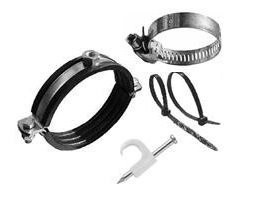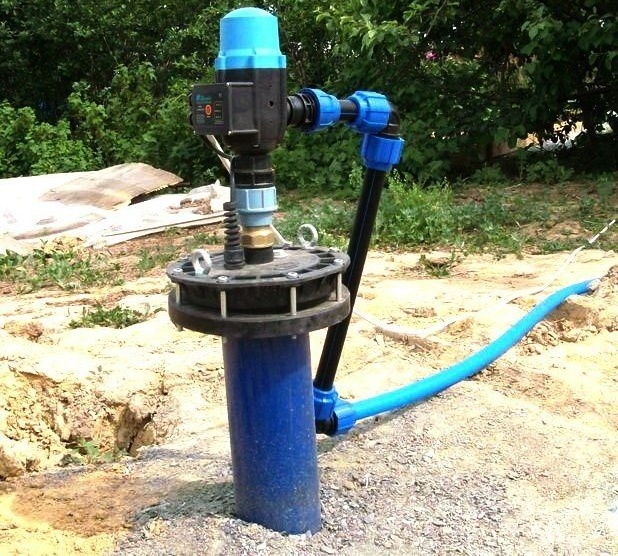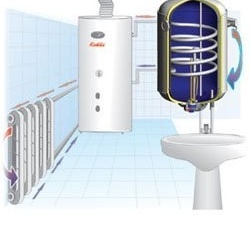Do-it-yourself bumper for a well: an example of manufacturing + how to work properly
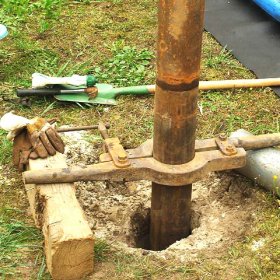
Many owners organize the supply of water to cottages and private houses from wells drilled on the site. When silting a source of water intake, the flow rate of the well decreases, as a result of which there is an acute shortage of water. When you turn on the tap, the water runs for a while, and then air starts to suck in. You can remove sand, silt accumulations and rust using a special machine if access to the well is free. The source is effectively cleaned with a pump or injection gun. However, this equipment is not always available. Meanwhile, you can also restore the well’s working capacity using a simple home-made tool made from a piece of pipe of a suitable diameter. A do-it-yourself bailer for a well allows you to clean the wellbore from accumulated sludge in a timely manner without resorting to outside help.
How to assemble a bailer on your own?
The order of work
You can construct a homemade tool using the following algorithm:
- take a pipe 80 cm long, the inner diameter of which is approximately 59 mm;
- buy, order from a turner or make yourself a metal ball, the diameter of which is 40 mm;
- the bottom is welded to the bottom of the pipe - a thick washer, the top of which has a funnel-shaped shape, while the saddle of the hole is adjusted to the diameter of the metal ball;
- from below the washer may have a flat, flat surface or the form of a return funnel;
- on the upper part of the pipe, a grid made of thick wire is welded by welding, which prevents the ball from flying out of the pipe;
- An arc is also welded to the upper end of the pipe, for which a thin metal cable or a nylon cord will cling.
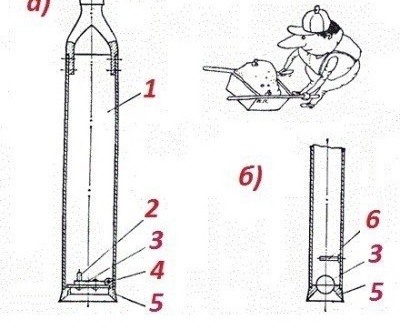
Chasers: a) with a flat valve; b) with a ball valve. Components: 1. pipe; 2. chop pin; 3. valve; 4. axis; 5.bashmak; 6. limiter
Important! To increase the efficiency of the designed bailer, a pair of strong metal canines can be attached to the tool from below, which, when immersed, will loosen sand and silt at the bottom of the well.
A method of manufacturing a metal ball
Many amateur craftsmen cannot find the ball of the desired diameter, so they are looking for options for its independent manufacture. To do this, a children's ball made of thick rubber or PVC is selected and cut into two halves. Then, lead shot or balls of bearings mixed with waterproof (epoxy) glue are placed in each half. Giving time for the adhesive to dry, the halves are sanded and glued together. With such a self-made ball-valve, the billet for cleaning the well will work properly for a long time.
How to clean a well with a bailer?
With the help of a long and strong cord (cable), the bellow is lowered into the well, reaching the bottom. Then the tool is raised half a meter from the bottom surface upwards, and sharply lowered.At the same time, the ball, jumping upward under the influence of water hammer, opens a hole in the bottom of the baffle, through which water mixed with sand and silt enters the pipe. Then the ball drops and closes the hole. For a more complete filling of the bailer, such movements are repeated three to four times, after which they begin to slowly and smoothly, avoiding jerking, raise the tool up. The contents of the baffle are poured, and it is again lowered into the well. To facilitate the work of lifting the baffle, a gate can be constructed.
Important! Depending on the design of the baffle, it is possible to lift up to 300 grams of sand and sludge from the bottom of the borehole in one go, which is about 3 cm of the layer height. After calculating the volume of recovered sediments, you can plan a schedule for cleaning the well to prevent a strong siltation of the source of water intake.
According to the method described above, a borehole valve is made having a ball valve. This design of the valve allows you to lift up the water with fine suspensions of silt and sand, as well as small pebbles and pieces of rust.
However, there are other methods for manufacturing the valve. For example, a flat-shaped valve:
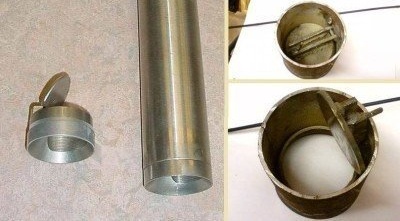
The design of the flat valve of a homemade bailer - also everything was done independently and from improvised means!
To design such a flat valve, welding and tools that any craftsman has are required. Some manage to make a valve even from a plastic bottle.
The use of baits when drilling
When arranging wells in loose, debris, loose rocks filled with water, you can also use a bailer. True, in this case, the instrument is made longer (up to 3-4 m) in order to grab and raise more rock in one go. The valve is made of a steel plate.
For sealing use leather or rubber. Instead of a cable, drill rods are used, for the manufacture of which gas rods are taken, the diameter of which is 33, 42 or 48 mm. There are known cases when drilling a borehole using a shock method was carried out using wooden rods equipped with metal tips. For the manufacture of drill rods used thin-layer spruce, ash, oak or larch.
As you can see, it is possible to make a bailer for periodic cleaning of a shallow well on your own. Although factory models are also available. Using this device, you can maintain the well in good working order and not leave the house without water. Remember that constant water intake prevents siltation of the well, which means it will have to be cleaned less often.

